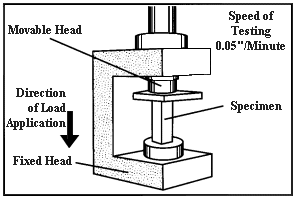Compressive Strength Test:
This test is carried out to determine the compressive strength of cement. The mortar of cement and standard sand is prepared. The proportion is 1: 3 which means that x gm of cement is mixed with 3x gm of standard sand. Instead of standard sand, ordinary sand passing through 850 micron IS sieve and not more than 10 % by weight passing through 600 micron IS sieve may be used. To perform this test, 200 gm of cement and 600 gm of standard sand by weight are taken and mixed dry in a non-porous mixing pan to uniform color with the help of a trowel for one minute. A water is added at the rate of P/4 + 3 percent of water when ordinary sand is used by weight of cement and sand mix together where P is the percentage of water required for a paste of standard consistency. It is mixed thoroughly to an even color for about three minutes. The cube mould made of metal of size 70.6 mm is placed on a non-porous base plate and is oiled from inside. The mould is fitted on the table of the vibrating machine. Immediately after mixing, the mortar is put into the cube mould and is compacted for two minutes by the vibrations of the machine, which runs at a speed of 1200 ± 400 vibrations per minute. The compaction and filling of mould should be finished within 5 minutes from the instant water is added to mortar. The mould is then removed and the top surface is smoothened off by the single stroke of a trowel. The prepared cubes are kept at a temperature of 27oC ± 2oC in an atmosphere of at least 90% relative humidity for 24 hours. Then the cubes of mortar are removed from the mould and immersed in water for curing until taken out for testing that is after 3 or 7 or 28 days.

Figure: Compressive Strength Machine